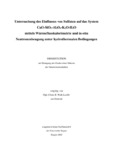Citation link:
https://nbn-resolving.org/urn:nbn:de:hbz:467-283Files in This Item:
| File | Description | Size | Format | |
|---|---|---|---|---|
| walk_lauffer.pdf | 5.3 MB | Adobe PDF |  View/Open |
| Dokument Type: | Doctoral Thesis | metadata.dc.title: | Untersuchung des Einflusses von Sulfaten auf das System CaO-SiO2-Al2O3-K2O-H2O mittels Wärmeflusskalorimetrie und in-situ Neutronenbeugung unter hydrothermalen Bedingungen | Authors: | Walk-Lauffer, Bernd | Institute: | Fachbereich 8, Chemie - Biologie | Free keywords: | Porenbeton, Zementhydratation, Neutronenbeugung | Dewey Decimal Classification: | 540 Chemie | GHBS-Clases: | ZLUE | Issue Date: | 2002 | Publish Date: | 2005 | Abstract: | Untersuchung des Einflusses von Sulfaten auf das System CaO-SiO 2 -Al 2 O 3 -K 2 O-H 2 O mittels Wärmeflusskalorimetrie und in-situ Neutronenbeugung unter hydrothermalen Bedingungen Porenbeton besteht aus den Rohstoffen Sand, Zement, Branntkalk, Wasser und Aluminiumpulver (zur Porosierung). Zusätzlich werden Sulfatträger zur Verbesserung der physiko-mechanischen Eigenschaften Druckfestigkeit und Schwindung eingesetzt. Ziel dieser Arbeit war es, die Wirkung von Sulfat bzw. verschiedener Sulfate in der Porenbetonproduktion festzustellen und mögliche Reaktionsmechanismen aufzuzeigen. Aufgrund des Produktionsablaufs ergaben sich drei Abschnitte, die betrachtet worden sind: 1. Der Zeitraum vor der hydrothermalen Härtung ist durch die Löschreaktion des Branntkalkes und die (nicht vollständig ablaufende) Zementhydratation geprägt. Die Löschreaktion von gebranntem Kalk wird verzögert durch: Erhöhung der Kalkbrenntemperatur (und/oder –dauer) Zusatz von Sulfatträgern (Verzögerung steigt mit der Sulfatlöslichkeit) Zusatz von Zement 2. Während der hydrothermalen Härtung konnte die Phasenentwicklung mittels Neutronenbeugung kontinuierlich verfolgt werden. Sulfate erniedrigen die Geschwindigkeit der Reaktion von Ca(OH)2 mit SiO2. Die hydrothermale Reaktion ist zunächst lösungskontrolliert (Bildung amorpher CSH-Phasen) und wird zunehmend durch Diffusionsprozesse beeinflusst (kristalline CSH-Phasen entstehen). Sulfate scheinen den ansonsten kontinuierlichen Übergang zwischen amorphen und kristallinen CSH-Phasen für einen Zeitraum von ca. 30 min. zu unterbrechen. 3. Sulfate erhöhen die Druckfestigkeit und senken die Schwindung des Produkts Porenbeton. Neben diesen positiven Einflüssen kommt es jedoch auch zu unerwünschten Nebenerscheinungen: Die Wärmeleitfähigkeit und die Menge eluierbaren Sulfats steigen. Ein hoher Alkaligehalt fördert die Sulfat-Eluierbarkeit aus dem Porenbeton. Autoclaved aerated concrete consists of the raw materials sand, cement, quicklime, water and aluminum powder (pore forming material). Additionally sulfate carriers are used to improve the physico-mechanical characteristics such as compressive strength and shrinkage. The aim of this work was to determine the effect of sulfate and/or different sulfates in the production of autoclaved aerated concrete (AAC). Because of the production process of AAC three sections were investigated: 1. The period before hydrothermal hardening is shaped by the hydration of the quicklime and the cement hydration (which is not completed at the end of this period). The slaking of burned lime is retarded: with increasing firing temperature and/or burning duration of the lime with addition of a sulfate carrier (the more soluble the bigger the retardation) with addition of cement 2. By means of neutron diffraction, phase development could be recorded continuously during hydrothermal hardening. Sulfates decrease the reaction rate of Ca(OH)2 with SiO2. At first, the hydrothermal reaction is solution-controlled (amorphous CSH phases are formed) and increasingly affected by diffusion processes (crystalline CSH phases appear). Sulfates seem to interrupt the expected continuous transition between amorphous and crystalline CSH phases for a period of approx. 30 min. 3. Sulfates increase compressive strength, lower shrinking of the autoclaved aerated concrete product. Apart from these positive influences, it also effects unwanted side effects: The heat conductivity and the quantity of soluble sulfate rise. A high alkali content promotes the sulfate solubility from the aerated concrete. |
URN: | urn:nbn:de:hbz:467-283 | URI: | https://dspace.ub.uni-siegen.de/handle/ubsi/28 | License: | https://dspace.ub.uni-siegen.de/static/license.txt |
| Appears in Collections: | Hochschulschriften |
This item is protected by original copyright |
Page view(s)
667
checked on Apr 3, 2025
Download(s)
397
checked on Apr 3, 2025
Google ScholarTM
Check
Items in DSpace are protected by copyright, with all rights reserved, unless otherwise indicated.

